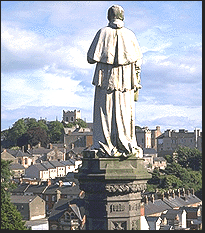 The City
of Armagh
The City
of Armagh
Original Official Site of the Northern Ireland Tourist Board

View from the Catholic Cathedral
The spiritual capital of Ireland for 1,500 years and the seat of both Protestant and Catholic archbishops, Armagh is the most venerated of Irish cities. St Patrick called Armagh 'my sweet hill' and built his stone church on the hill where the Anglican cathedral now stands. On the opposite hill, the twin-spired Catholic cathedral (started in 1840) is flanked by two large marble archbishops who look mildly across town.
Many of the public buildings and the Georgian townhouses along the Mall are the work of Francis Johnston, a native of Armagh, who also left his mark on Georgian Dublin. The builders of Armagh delighted in the warm coloured local limestone that makes the city glow on the dullest day. They called it 'Armagh marble'. The archbishop's palace and the courthouse are good examples.
When it's polished, the slabs of pink and yellow and red limestone are made into doorsteps and pavements - like the glowing pink pavement on the Mall. You will also see plenty of it in the Catholic cathedral.
The present Anglican cathedral is mostly a 19th-century restoration round the 13th-century shell. Thackeray admired the new building when he came this way in 1842, and he specially liked the monuments which then, as now, included ones by Roubiliac, Chantrey, Rysbrack and Nollekens.
'It wants a hundred years at least,' he said, 'to cool the raw colours of the stones, and to dull the brightness of the gilding, all which benefits, no doubt, time will bring to pass...'
Brian Boru, who drove the Norsemen out of Ireland in 1014, is buried in the churchyard. The cathedral library, founded in 1771 by Archbishop Robinson who also built the observatory, has a copy of Gulliver's Travels corrected in Swift's hand, and the Claims of the Innocents (pleas to Oliver Cromwell).
Armagh Planetarium:
Located on the grounds of the 18th century Armagh Observatory in Armagh
City, the planetarium has been upgraded for visitors and scientists.
An Eartharium, with displays examining the Earth's core, surface and
atmosphere, opened last summer. Price: about US$5.60.
Palace Stables:
A heritage center in the stables of Armagh's 1770 palace demesne explores
a day in the life of the palace in 1776. Also open to the public is the
archbishop's chapel. Price: about US$4.20.
St. Patrick's Trian:
Located in three 18th and 19th century buildings in downtown Armagh, St. Patrick's Trian, named for the city's historic division into three districts. The Armagh Story, with its illustrated wall panels, audiovisual displays, sound effects and narrative explanations, explores the evolution of belief, focusing on ancient times, Patrick's arrival to Armagh, the Viking invasions of Ireland and contemporary society. The land of Lilliput, inspired by the "Gulliver's Travels" of Jonathan Swift, who spent much time in Armagh, features huge models of Gulliver and tiny Lilliputians. Price: about US$4.80.
County Armagh Overview | The City of Armagh | The Armagh Villages
Northern Ireland Homepage | Travel Tips | Golf | Industrial Heritage | Walking, Hiking & Horseback | Activities | Calendar of Events | Transportation | Cuisine and Restaurants | Birdwatching | Fishing | Ancestral Heritage | County Antrim | County Armagh | City of Belfast | County Down | County Fermanagh | County Londonderry | County Tyrone | Tour Operators | InterKnowledge Home Page
Copyright (c) 1995-1997 interKnowledge Corp. All rights reserved.
